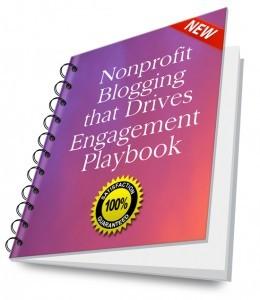
Address the elephant and dinosaurs in the room
In Part 1 of this two-article series I walked you through some steps to create a rough draft of a marketing communications plan that will serve you in the current digitally-revolutionized and highly networked world. Not what you’ve been doing every year for the past decade, but something that will really serve you in today’s competitive marketplace.
Now that you’ve got the rough draft of a plan (If not, go back to Part 1), I’ll bet there’s a constant thread running through it. Most folks I talk with want, and need, to become more digitally proficient. If this did not come up for you, you may need to address the elephant (and dinosaurs) in the room.
Because if you’ve not reached consensus in your organization that online, inbound marketing is critical to fundraising in the current nonprofit zeitgeist, you’re going to need to sit down with folks and have difficult conversations. At least if you want to survive and thrive, and not become the next Borders and Books or Blockbuster Video. If everyone you want to reach is where you’re not, what does that tell you?
Okay, so what do you do next to face your particular challenges and hone your marketing plan so it best addresses them?
You don’t have to go from 0 to 60 in a nanosecond. You do, ultimately, have to get where you’re going. Be patient, but persevere. Think big, but move incrementally.
Here are four ways to get there.
1. Develop the Capacity and Staff You Need
Be honest with yourself. What can you do; what can’t you do? Don’t use the fact you can’t do everything to justify doing nothing. Yet don’t stress out if you don’t have resources for tons of digital and content marketing. Do what makes the most sense to get to that point. You’ll want to get there, because digital is quickly becoming the ‘go-to’ way folks communicate. Especially younger generations, but older generations as well. We’re all lumped together as “GenC” (Generation Connected). You’ll get there. But…
Begin where you need to begin.
Focus first on fundraising.
It never makes sense to focus on “awareness building” at the expense of fundraising. Work towards getting to the place where the two work seamlessly together. Because marketing and fundraising really are like peanut butter and jelly.
There’s no sense attracting leads if you don’t place a priority on converting leads to donors. And then on keeping the donors you have. So don’t forget to prioritize the basics.
Conduct a mini-audit of your marketing communications needs and current resources in support of fundraising.
- Pick a budget number – what do you need to accomplish your goals, both to stay afloat and to increase staff capacity in priority areas (e.g., online fundraising; content creation; digital marketing)?
- What small steps can you take to get there?
- Focus on fundraising first. If you have zero capacity for marketing, don’t focus on social media first. Get offline and begin calling and meeting with people.
- Ask your board members to help you as ambassadors, advocates, referral sources, door openers and askers.
- Build individual relationships w/people who’ll help you raise money.
- Consider what skills can be outsourced so you can focus on what you do best.
When capacity is a challenge, less truly is more.
Quality trumps quantity. Something worth doing is worth doing well. Embrace this! It’s better to go deep in one social network than to be mostly absent in a bunch of them. If you tweet just once a month, Twitter isn’t helping you. If the last time you blogged was six months ago, that’s not helping you either. One of the ways search engine algorithms work is by noticing your most engaged content (e.g., blog posts, articles, videos, web pages). If you don’t have time to religiously create and engagingly share online content, wait until you do. Otherwise you’re wasting your time.
2. Consistently Create and Publish Relevant Content
If there’s no there there, no one will notice you. Sticking to a schedule will help you show up. And that’s half the battle.
When it comes to building relationships with your constituents, absence will not make the heart grow fonder. It really is a case of “out of sight, out of mind.”
If you’re having trouble managing everything, first commit to being online through (1) your website and (2) email (includes a blog and/or e-newsletter). These are still your top two methods of communication. Next, evaluate your social media options by asking yourself two important questions:
(1) Do we really need to be here?
(2) If we do need to be here, what type of content will folks appreciate, and what will our digital persona be??
Do we really need to be here?
You do, if it’s someplace your peeps hang out a lot. So find out. Ask folks in a quick survey using SurveyMonkey or Googledocs.. Or ask them on your fundraising remit form or volunteer intake form.
Questions you might ask include:
- Where do you get your news?
- How do you stay in touch with your friends?
- How do you network for work?
- List in rank order each of the following social media networks you use
- How often do you check email?
- How often do you check social media?
What type of content and tone will folks appreciate?
Each channel has different best practices. Listen and do some research on each channel. Notice which content is liked and shared generally as well as for your organization. Notice which of your links are opened. Use Google Analytics to evaluate what’s going on.
Now consider which channels could be improved if approached more strategically. For more on how to approach this, see Heather Mansfield’s excellent article on 4 signs your nonprofit should quit a social network. Once you’ve picked your top candidates, to maximize engagement you’ll likely want to tweak your content for different networks. But you don’t have to create completely new content. Just make sure all your content is informed by your constituents.
Consider the following:
- What do engagers want to know more about?
- What gets them passionately inspired or pissed off?
- Where are their knowledge gaps, and where can you fill in?
- What do they want to hear?
Tell and show (videos are the most frequently shared type of content). Relate to current events that are on folks’ minds as much as you can. Earn trust and authority before you ask folks for something. I always say: If you want gifts, you must give them.
3. Build Your Marketing Calendar, Step-by-Step
You need to commit to writing up a plan and building in accountability. What you’ll do. When you’ll do it. Who will do it. And who will hold the ‘doers’ feet to the fire. So… grab your draft and get in planning mode.
- Book out time
- Find a partner (or several) to bounce ideas off of and help you stay on track
- Get office supplies (Easels; Whiteboards; Markers; Notebooks, Laptops, Chargers, etc.) that excite you – make this fun, not painful
- Evaluate last year
— What worked?
— Almost worked?
— Needs tweaking
— Should abandon
- Write down activities you’ve been dying to try
- Choose one marketing activity you’ve been dying to try and commit to making it happen (this can even be just to learn more or get some training)
- Dream BIG – what would your most wildly successful year ever in marketing look like? Put all your big dreams in writing. No idea is too big.
- Break your chosen dream into mini-goals (Here are a few suggestions from Julia Campbell – and me):
— Start a social media ambassador program
— Run more ads
— Share more videos and photos
— Participate in tweet chats
— Start a blog and make it your content marketing workhorse
— Launch a digital storytelling campaign
— Create an email welcome series for new email subscribers
- Turn mini-goals into projects with measurable objectives/phases/strategies — ideation; creation; promotion
- Create a checklist of assets you have in place (staff, budget, tools)
- Create a prioritized wish list of assets you need to add
- Add a budget and make assignments with deadlines
- Build in follow through. Block out time to complete tasks in your project plan. Try to avoid distractions when doing creative work or content creation.
- Build in time to research time-saving and cost-saving tools (See Keeping Up with Nonprofit Content Marketing and Social Media Tools).
4. Reinvent the Way You Use Technology to Communicate and Fundraise
Honestly, you have no other choice. Slowly but surely, you must meet your supporters where they are. They communicate differently today than they did 10 years ago. Even five years ago. They give differently too. Technology has become an essential ‘cost of doing business’ – and this holds just as true for nonprofit fundraising as for anything else.
If you’re to attract people’s attention, inspire engagement and secure investment, you’ll need to make technology your friend.
The easiest way to determine how much is an appropriate investment in staff, hardware, and services for a nonprofit of your size is to download the free NTEN Annual Technology Staffing and Investments Report. The Report distinguishes between organizations that are leading, operating, functioning and struggling, so you can see where you might fit. And where you, hopefully, are headed.
SUMMARY: Steps to Address Nonprofit Marketing Challenges Head On
- Figure out where you want to grow.
- Figure out what you need the most to get there.
- Figure out what’s holding you back.
- Put a plan in writing that’s realistic, yet takes some risks.
- Develop a budget so you can spend your resources wisely.
- Track your results and measure the return on your investment.
- Tinker and fine tune.
What are your biggest challenges right now? Please share in the comments below.
Want to Drive Greater Engagement with Constituents?

4 Companion Volumes to drive awareness and support
The Nonprofit Blogging That Drives Engagement Playbook will help you develop a comprehensive content marketing strategy that will drive folks to your website to take the actions you want them to take! I consider blogging to be a great shortcut to successfully engaging folks and converting them to donors. I’ve taken everything I’ve learned about blogging and engaging nonprofit communications and tucked it into 4 handy no-nonsense guides to help you become a “player” in the blogosphere. As will all my products, this comes with a 30-day no-questions-asked 100% refund guarantee.





